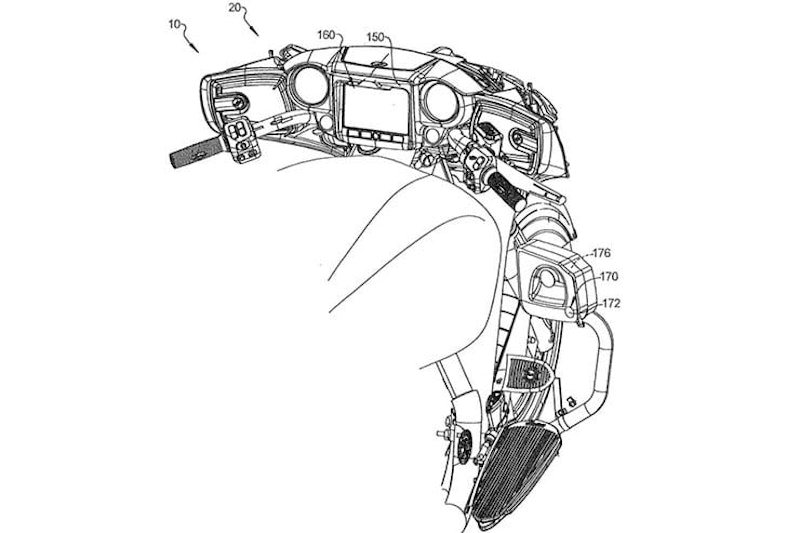Indian developing camera and radar safety system
By Ben Purvis
Motorcycle Journalist
30.06.2021
Radar has burst onto bikes this year with systems from Ducati, BMW and KTM but ever-cheaper components mean future bikes are likely to combine multiple radars and cameras working in harmony – and that’s precisely what Indian is working on right now.
The firm has filed patent applications for a suite of sensors that provide not only adaptive cruise control, allowing the bike equipped with the system to keep pace with traffic ahead, but also to monitor the vehicles behind and to either side and alert the rider if they pose a risk.
We’ve already seen radar cruise control on the likes of Ducati’s Multistrada V4 and BMW’s R150RT, plus KTM’s latest 1290 Adventure S. It monitors the distance to objects and vehicles ahead and allows the use of an adaptive cruise control to keep a constant distance from them even as speeds change.
Where Indian’s setup gets more intriguing is in the sheer number of additional sensors, with a particular focus on rear-facing cameras. The patent – illustrating an extreme version of the system – shows five camera positions. Two are mounted on the engine crash bars just below the mirrors. These are angled to look backwards and to the sides, covering much the same area that you might expect to see in the mirrors.
As well as these, another two cameras are fitted in the rear edges of the panniers, with wider-angle lenses to give an expanded view to each side and behind. A fifth camera, facing directly backwards, is fitted near the taillight.
You might think that would have you covered, but Indian’s patent also includes not one but two rear-facing radars, also mounted in the back edge of the panniers and each angled to cover an area behind and to one side for a wide ‘view’ of other traffic.
Why cameras and radar? The answer is that the radar is tasked with sensing the position and movement of other vehicles relative to the bike, while the cameras can then relay an image of that vehicle to the rider via a large central display on the dash.
The idea is that the cameras are normally switched off. You ride normally, using the mirrors to see what’s behind. But if a car or other vehicle is approaching in such a way that it might hit you, the most appropriate camera can be used to display an image what’s happening on the screen.
Since the camera image alone might not give you instant understanding of the direction that vehicle is coming from, the system is also designed to incorporate lights and haptics to indicate where the hazard lies. The lights, which the patents suggests could be positioned in the mirrors or an additional display panel on the dash, show the direction of the danger. As well as that, four haptic vibration motors are mounted in the seat – one on each side, one at the front and one at the back – controlled by a computer. By altering which haptic motors are operated, the system gives a physical indication of the direction to focus your attention in.
It's all very well telling you, the rider, when a car is barrelling towards you from behind, but there isn’t always you can do about it, particularly if you’re in traffic or waiting at junction.
Here, Indian’s system is also intended to help. The patent suggests that if it’s a low risk, based on the closing speed and distance of the other vehicle, it will automatically flash your hazard lights – rather like some vehicles already do when they’re braking particularly hard – to attract the other driver’s attention. If that’s not enough and the vehicle gets closer or doesn’t slow down significantly, the bike will automatically flash the brake light and sound its horn.
While there’s no guarantee even then that the doziest of drivers will notice, the Indian system certainly appears to boost your chances of being spotted.
Of course, a patent application alone is far from a guarantee that a technology will reach production, but the technology in Indian’s setup is very much available right now, and the firm has an increasingly strong reputation of operating at the cutting edge when it comes to tech so a radar and camera-assisted safety system seems very likely to be on its way to showrooms in the not-too-distant future.
Indian’s radar system also appears to promise a wider array of adjustability than other setups, as the patent application includes the ability to identify the type of vehicle in front and allows you to set different following distances depending on what you’re behind.
Even when the cruise control isn’t set, the radar has the ability to warn you if you’re getting too close to another vehicle, but you might prefer that distance to change for different types of vehicle. For instance, if you’re riding in a group (particularly when the bikes are staggered) you might want to stay closer to the bike in front than you would if it was a car or a truck. Indian’s system shows a dashboard display that differentiates between motorcycles, cars, pickups and lorries, allowing a different range of settings for each.
Here, the patent also hints that the system will be offered on bikes other than its big tourers, adding an image of an Indian Scout fitted with a simple LCD text display in its speedo that reads out the type of vehicle you’re behind.
Finally, Indian’s new patent contains a couple of images that just might hint at another development, although it’s not specifically mentioned in the document. Some of the drawings of the bike’s bars and dash, while detailed, lack a clutch lever. Does Indian have some semi-automatic transmission plans that it’s not telling us about?
Share on social media:

